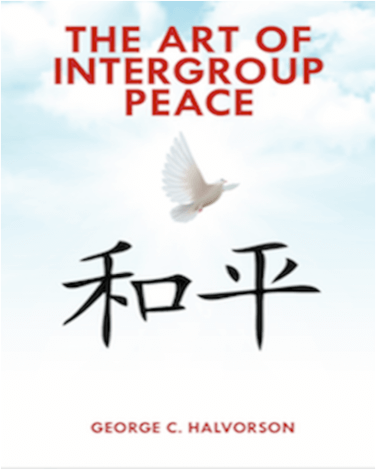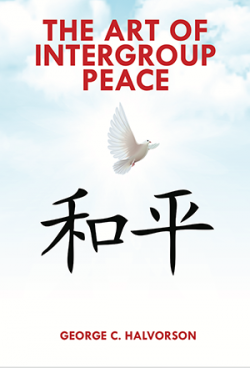Blog
The Art of InterGroup Peace: New Edition

September 8, 2016

The book, The Art of InterGroup Peace, has just been re-issued as a second edition.
The new edition deals more directly with issues and topics like Black Lives Matter, Ferguson, the shootings in Paris and Brussels, and the immigration and alienation backlashes happening in Europe and the Middle East.
The new edition has a clearer chapter on how to use the six key alignment triggers in any setting to help bring people together.
It has a painfully clear and more direct chapter about why helping all children from all groups in the first three years of life is key to intergroup Peace in America.
That chapter on the development of children’s brains also explains why we need our local police forces doing a great job of becoming “Us” to the people in the communities they serve.
It also explains that we need to do a much better job of creating population health agendas and strategies that help improve the health of people from every group in each community.
There are major differences and even significant disparities in the health status for too many people in too many communities. Those disparities are outlined in the book Ending Racial, Ethnic and Cultural Disparities in American Health Care. This new edition of The Art of InterGroup Peace now echoes the need to reduce disparities and improve health to reduce the crippling impact of chromic conditions on people from all groups.
The bulk of that chapter, however, deals with the important fact that children’s brains build their most important neuron connections — the connections that give each brain its functional strength — in the first three years of life for each child.
Children whose brains are exercised in those first years have stronger brains. Children who have fewer direct interactions — and whose brains do not get that exercise — fall behind by age three, and most never catch up.
We need to do what needs to be done to make sure children from every group do not fall behind by age three.
The most recent national learning tests for children in our schools reported 70 to 80 percent of the majority group children in most schools were reading at high school levels — but only 30 to 50 percent of the minority group children, in too many schools, were either reading at age level, or doing their basic math computations at age level in high school.
The science shows us that children who are far behind by the third grade seldom catch up in high school. Children far behind by age three generally never catch up at all.
The Art of InterGroup Peace now has a very clear chapter explaining the biological science and the time frames behind those learning gaps for far too many children.
We all need to understand what is really happening for those children. The learning gap issues that appear to be ethnic or racial are actually not either one. That perception of race and ethnicity causing those gaps is absolutely and entirely wrong. It could not be more wrong.
The issues that create those learning gaps are not ethnic or racial. They are not genetic, and they are not cultural.
They are purely experiential. Children who do not get brain exercise in those years fall behind, and children from all groups who do get the right, direct experience in those key years, have much stronger learning skills and do really well later, on those tests at both third grade and in high school.
We need every family, every parent, and every group in America to understand that those learning gaps are created for each child by the experiential reality for each child in those key three years.
The book Three Key Years — available electronically at no charge on this website — and Chapter Eleven of The Art Of InterGroup Peace — both explain those realities and processes.
We can’t make the progress we need to make in multiple areas for both learning gaps and economic issues until we deal with those issues. Children who have fallen behind by age three tend to not be able to read when they get to school. They tend to drop out of school. They often end up in jail.
Multiple studies in a number of settings have shown, with no possibility of the studies being wrong or inaccurate, that high school drop-outs from every group are far more likely to go to jail than the other people from their own group who graduated from school. That issue and its significance relative to intergroup Peace in America, is now described very clearly in the next edition of that book.
The new edition of The Art of InterGroup Peace also has a clearer and more direct final chapter describing more clearly the core values we need to use to create a clear and functional sense of “Us” as a country.
We are extremely diverse as a country today, and we are becoming more diverse at an accelerating rate. One-half of the births in our country this year are from our various minority groups. In one year, more than half of the children in our public schools will be from our minority groups.
Our growing diversity is not a hypothetical or theoretical future possibility. It is actual, and it is both immediate and real. We are extremely diverse as a country today, and our diversity is growing at a rapid rate.
To succeed and thrive as the best nation on the planet, we will now need our diversity to be both a great strength and a major asset.
We can do that — and we can do that really well — but that will require us to be aligned with each other very directly and very clearly, as a values-based American “Us.”
We need to avoid dividing into warning subsections based on their ethnicity, race, culture, or even economic status. We need to be a wonderful, aligned, and mutually supportive “Us” based on our enlightened values, and our motivational and inspirational shared beliefs.
Those shared beliefs are now outlined and described more clearly as a set of aligning beliefs in the rewritten final chapter of The Art Of InterGroup Peace. We need to have our beliefs steer us and align us, and we need our explicit shared beliefs to inspire us to higher levels of success as a nation and a people.
If we don’t make the decision very intentionally and explicitly to move in that aligning direction, then we will instinctively divide into our pieces, and we will become just another multi-tribal nation at war with itself.
The new edition of The Art of InterGroup Peace is clearer than the last edition about those aligning values and why we need to use them to bring us together, and to achieve and protect the future we share.
Thank you to everyone who provided feedback to the first edition of the InterGroup Peace book in ways that helped shape the new edition into the set of learnings and perspectives that it is now.
Enjoy the book. You can order it from Amazon in hard-copy for about $10 — and you can download the entire text, or read it chapter-by-chapter (from this very website), free of charge.
Please. Let me know what you think of this enhanced version of The Art of InterGroup Peace. I suspect Sun Tzu had at least two editions for The Art of War. This is probably not the last edition or the last round of enhancements for The Art of InterGroup Peace.
Peace in our time ought to be our goal. This book is intended to help us achieve that goal.
Be well.
George
